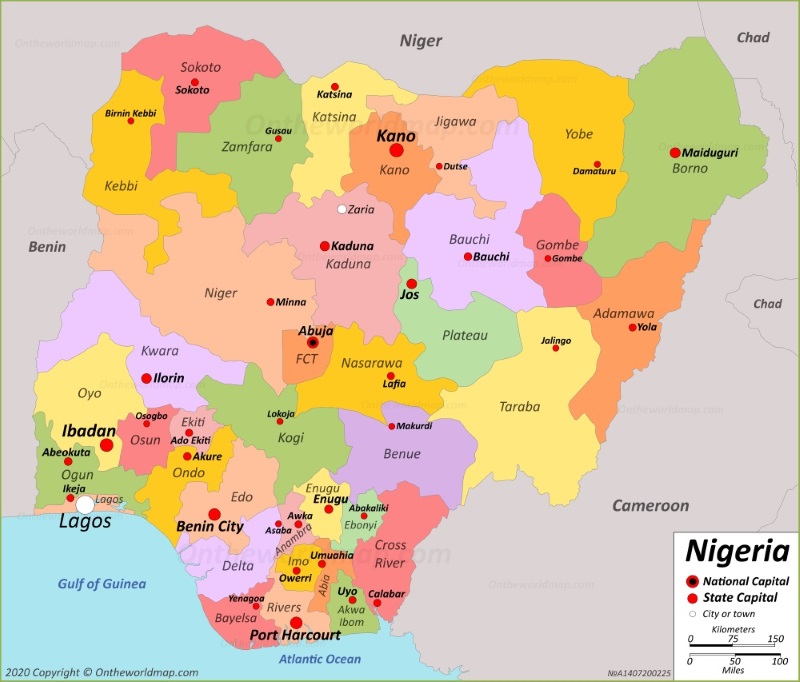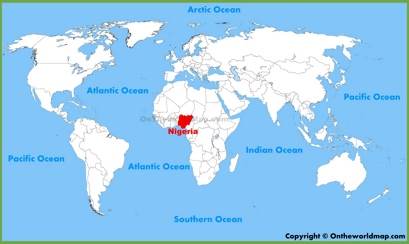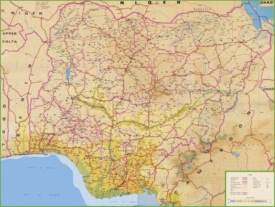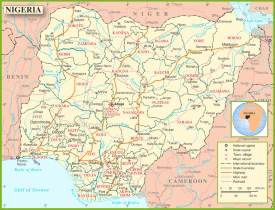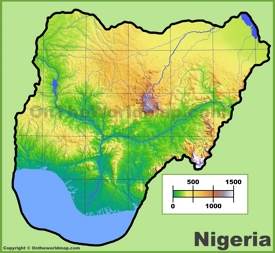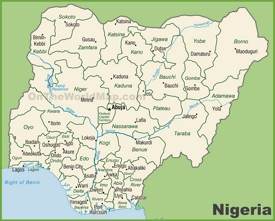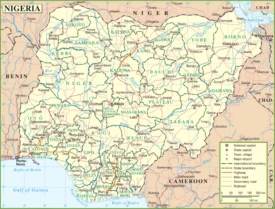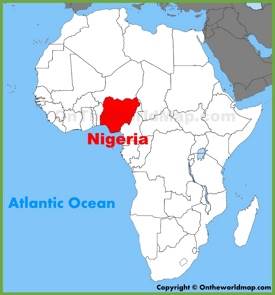Nigeria Map
Description:
This map shows governmental boundaries of countries; states, state capital cities, and major cities and towns in Nigeria.
You may download, print or use the above map for educational, personal and non-commercial purposes. Attribution is required. For any website, blog, scientific research or e-book, you must place a hyperlink (to this page) with an attribution next to the image used.
Online Map of Nigeria
About Nigeria
Nigeria, officially the Federal Republic of Nigeria, is a country located in West Africa. It is the most populous country in Africa with over 236 million inhabitants. The country's capital is Abuja, while its largest city is Lagos.
Nigeria is bordered by Niger to the north, Chad to the northeast, Cameroon to the east, and Benin to the west. The country's southern coast lies on the Gulf of Guinea in the Atlantic Ocean. The official language is English, though there are over 500 indigenous languages spoken throughout the country.
The economy of Nigeria is the largest in Africa, with a GDP of $477 billion (2022). It is a major producer of petroleum and has the largest natural gas reserves on the continent. The country gained independence from British colonial rule in 1960.
Nigeria is divided into 36 states and the Federal Capital Territory. The country operates under a presidential system of government. The climate varies from arid in the north to tropical in the south. The country's landscape includes the Sahel savanna in the north, tropical rainforests in the south, and the Niger Delta region along the coast.
Nigerian culture is known for its diversity, with over 250 ethnic groups. The largest ethnic groups are the Hausa, Yoruba, and Igbo. The country is roughly divided between Muslims in the north and Christians in the south.
The Facts:| Flag: |

|
| Capital: | Abuja |
| Largest city: | Lagos |
| Area: | 356,669 sq mi (923,769 sq km) |
| Population: | ~ 236,747,130 (2023 estimate)[1] |
| Official language: | English |
| National languages: | Hausa, Igbo, Yoruba |
| Religion: |
|
| Ethnic groups: |
|
| Currency: | Naira (₦) (NGN) |
| Driving side: | Right |
| Calling code: | +234 |
| Internet TLD: | .ng |
| Time zone: | UTC+01:00 (WAT) |
| Gross domestic product (PPP) (2024 estimate): |
|
| Gross domestic product (nominal) (2024 estimate): |
|
| Official government website: | nigeria.gov.ng |
Google Map of Nigeria
List of Largest Cities in Nigeria
- Maiduguri
- Ife
- Bauchi
- Akure
- Abeokuta
- Uyo
- Oyo
- Sokoto
- Owerri
- Yola
- Calabar
- Umuahia
- Ondo
- Minna
- Lafia
States of Nigeria
| State | Capital | Area | Population |
|---|---|---|---|
| Abia | Umuahia | 6,320 sq km (2,440 sq mi) | 3,841,943 |
| Adamawa | Yola | 36,917 sq km (14,254 sq mi) | 4,536,948 |
| Akwa Ibom | Uyo | 7,081 sq km (2,734 sq mi) | 4,780,581 |
| Anambra | Awka | 4,844 sq km (1,870 sq mi) | 5,599,910 |
| Bauchi | Bauchi | 45,893 sq km (17,719 sq mi) | 7,540,663 |
| Bayelsa | Yenagoa | 10,773 sq km (4,159 sq mi) | 2,394,725 |
| Benue | Makurdi | 34,059 sq km (13,150 sq mi) | 5,787,706 |
| Borno | Maiduguri | 70,898 sq km (27,374 sq mi) | 5,751,590 |
| Cross River | Calabar | 20,156 sq km (7,782 sq mi) | 4,175,020 |
| Delta | Asaba | 17,698 sq km (6,833 sq mi) | 5,307,543 |
| Ebonyi | Abakaliki | 6,400 sq km (2,500 sq mi) | 3,007,155 |
| Edo | Benin City | 19,559 sq km (7,552 sq mi) | 4,461,137 |
| Ekiti | Ado Ekiti | 6,353 sq km (2,453 sq mi) | 3,350,401 |
| Enugu | Enugu | 13,161 sq km (5,081 sq mi) | 4,396,098 |
| Federal Capital Territory | Abuja | 7,315 sq km (2,824 sq mi) | 1,406,239 |
| Gombe | Gombe | 18,768 sq km (7,246 sq mi) | 3,623,462 |
| Imo | Owerri | 5,530 sq km (2,140 sq mi) | 5,167,722 |
| Jigawa | Dutse | 23,154 sq km (8,940 sq mi) | 6,779,080 |
| Kaduna | Kaduna | 46,053 sq km (17,781 sq mi) | 8,324,285 |
| Kano | Kano | 20,131 sq km (7,773 sq mi) | 14,253,549 |
| Katsina | Katsina | 24,192 sq km (9,341 sq mi) | 9,300,382 |
| Kebbi | Birnin Kebbi | 36,800 sq km (14,200 sq mi) | 5,001,610 |
| Kogi | Lokoja | 29,833 sq km (11,519 sq mi) | 4,153,734 |
| Kwara | Ilorin | 36,825 sq km (14,218 sq mi) | 3,259,613 |
| Lagos | Ikeja | 3,577 sq km (1,381 sq mi) | 12,772,884 |
| Nasarawa | Lafia | 26,256 sq km (10,137 sq mi) | 2,632,239 |
| Niger | Minna | 76,363 sq km (29,484 sq mi) | 6,220,617 |
| Ogun | Abeokuta | 16,981 sq km (6,556 sq mi) | 5,945,275 |
| Ondo | Akure | 15,500 sq km (6,000 sq mi) | 4,969,707 |
| Osun | Osogbo | 9,251 sq km (3,572 sq mi) | 4,237,396 |
| Oyo | Ibadan | 28,454 sq km (10,986 sq mi) | 7,512,855 |
| Plateau | Jos | 30,913 sq km (11,936 sq mi) | 4,400,974 |
| Rivers | Port Harcourt | 11,077 sq km (4,277 sq mi) | 7,034,973 |
| Sokoto | Sokoto | 25,973 sq km (10,028 sq mi) | 5,863,187 |
| Taraba | Jalingo | 54,473 sq km (21,032 sq mi) | 3,331,885 |
| Yobe | Damaturu | 45,502 sq km (17,568 sq mi) | 3,398,177 |
| Zamfara | Gusau | 39,762 sq km (15,352 sq mi) | 5,317,793 |
Geography of Nigeria
Nigeria occupies 356,669 square miles (923,769 square kilometers) in West Africa, bordering Benin, Niger, Chad, and Cameroon. The country extends between 4° and 14° North latitude and between 2° and 15° East longitude. The Niger and Benue rivers form the country's primary drainage system, converging at Lokoja and creating a distinctive "Y" pattern.
The terrain comprises four major geographical regions: the northern savanna plains, the central Middle Belt, the southern rain forests, and the coastal swamps. The Jos Plateau, rising approximately 1,800 meters above sea level, stands as the country's most significant highland area. In the northeast, the Mandara Mountains mark the border with Cameroon.
Nigeria's climate exhibits two distinct seasons: the wet season (April to October) and the dry season (November to March). The annual rainfall varies significantly, from over 3,000mm in the southern coastal areas to less than 500mm in the northeastern regions. Temperature ranges remain relatively constant throughout the year, with averages between 25°C and 30°C.
The vegetation patterns follow the rainfall gradient, transitioning from mangrove swamps and rainforests in the south to Sudan savanna and semi-desert conditions in the north. The Niger Delta, covering approximately 70,000 square kilometers, represents one of Africa's largest river deltas and contains vast oil reserves that drive Nigeria's economy.
Soil erosion, deforestation, and desertification present significant environmental challenges, particularly in the northern regions where the Sahel's influence continues to expand southward. These geographical factors significantly influence the country's agricultural patterns, population distribution, and economic activities.
Major Rivers of Nigeria
- Niger River - 2,597 mi (4,180 km)
- Benue River - 870 mi (1,400 km)
- Cross River - 489 mi (787 km)
- Kaduna River - 342 mi (550 km)
- Gongola River - 331 mi (533 km)
- Sokoto River - 329 mi (530 km)
- Ogun River - 320 mi (515 km)
- Hadejia River - 298 mi (480 km)
- Zamfara River - 280 mi (450 km)
- Yobe River - 279 mi (449 km)
- Osun River - 267 mi (430 km)
- Anambra River - 260 mi (418 km)
- Imo River - 241 mi (388 km)
- Katsina Ala River - 220 mi (354 km)
- Moshi River - 219 mi (352 km)
- Taraba River - 205 mi (330 km)
- Donga River - 198 mi (319 km)
- Ankwe River - 190 mi (306 km)
- Pai River - 186 mi (299 km)
- Rima River - 180 mi (290 km)
Lakes of Nigeria
- Lake Chad - 521 sq mi (1,350 km2)
- Kainji Lake - 502 sq mi (1,300 km2)
- Lake Oguta - 180 sq mi (466 km2)
- Jebba Lake - 150 sq mi (388 km2)
- Tiga Lake - 73 sq mi (189 km2)
- Shiroro Lake - 115 sq mi (298 km2)
- Goronyo Lake - 81 sq mi (210 km2)
- Dadin Kowa Lake - 77 sq mi (200 km2)
- Bakolori Lake - 31 sq mi (80 km2)
- Lake Abaya - 29 sq mi (75 km2)
- Lake Bamendjing - 25 sq mi (65 km2)
- Zaria Lake - 23 sq mi (60 km2)
- Agulu Lake - 21 sq mi (54 km2)
- Lake Oyan - 16 sq mi (41 km2)
- Asejire Lake - 15 sq mi (39 km2)
- Lake Pandam - 13 sq mi (34 km2)
- Lake Alau - 12 sq mi (31 km2)
- Lake Efi - 10 sq mi (26 km2)
- Lake Biu - 8 sq mi (21 km2)
- Lake Kiri - 7 sq mi (18 km2)
Brief History of Nigeria
Nigeria's history spans thousands of years, with archaeological evidence indicating human habitation dating back to 11,000 BCE. The region developed several sophisticated pre-colonial civilizations, including the Nok culture (500 BCE - 200 CE), known for its advanced terracotta sculptures and iron-working techniques.
The medieval period saw the rise of powerful kingdoms and empires. The Kanem-Bornu Empire (700-1900) dominated the northeastern region, while the Oyo Empire (1400-1835) controlled the southwestern territories. The Benin Empire (1440-1897) established significant trade relations with European powers, particularly Portugal, through ivory, palm oil, and slave trade.
British colonial influence began in Lagos in 1861. The Royal Niger Company established control over the southern regions in the late 19th century. In 1914, British colonial administrator Lord Frederick Lugard amalgamated the Northern and Southern Protectorates, creating modern Nigeria. This amalgamation brought together diverse ethnic groups, including the Hausa-Fulani, Yoruba, and Igbo, under one administrative structure.
Nigeria gained independence from British rule on October 1, 1960. The country experienced political turbulence, including a civil war (1967-1970) following the attempted secession of the Eastern Region as Biafra. Military regimes ruled Nigeria for nearly 30 years, with brief periods of civilian government. General Ibrahim Babangida's regime (1985-1993) introduced structural adjustment programs that significantly impacted the economy.
Democracy returned in 1999 with Olusegun Obasanjo's election as president. Subsequent leaders faced challenges including religious tensions, corruption, and economic diversification from oil dependency. Nigeria emerged as Africa's largest economy in 2014, driven by telecommunications, entertainment, and services sectors. The country continues to address security challenges, particularly from Boko Haram insurgency in the northeast, while maintaining its position as a significant regional power in West Africa.

